Flowering Dogwood
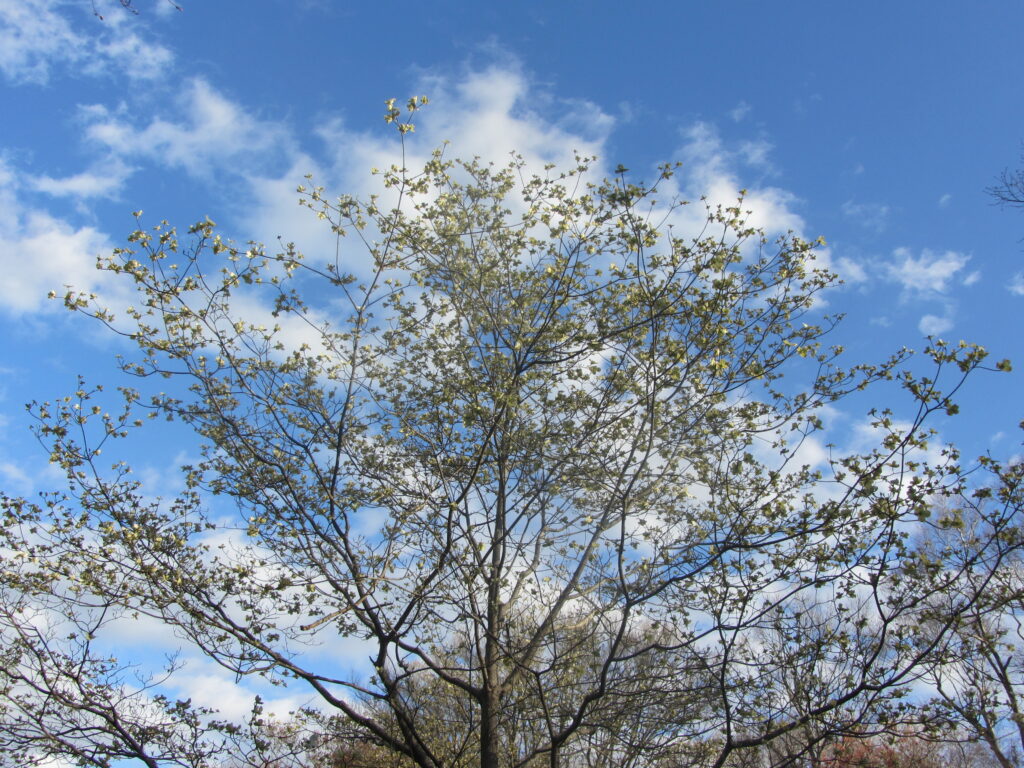
Flowering dogwood, Cornus florida
Dogwood trees explode into a profusion of flowers each spring. They grow wild along the forest edge, in clearings and along highways throughout Virginia, transforming from grey woody skeletons into graceful clouds of pink or white flowers as winter melts into spring each April.
The State Tree of Virginia
Flowering dogwood trees are cultivated in neighborhoods, around schools, in old church yards, and in private and public gardens, wherever they can shelter in the afternoon shade of taller trees or buildings. Their springtime beauty earns them a prominent position in the landscape and demonstrates why they were chosen more than a century ago, in 1918, as the state flower and the state tree of Virginia. Flowering dogwood, Corunus florida, was also designated as the state flower of North Carolina in 1941 and the state tree of Missouri in 1955. Dogwoods grow to only 20’- 30’ high, making this graceful tree a good landscape choice close to one’s home.
A Flowering Ambassador for Peace
The United States government donated 40 flowering dogwood saplings to Tokyo in 1915 as part of the exchange of friendship and flowers with the Japanese government in 1912-1915. This is when the Japanese government presented its first gift of flowering cherry trees to Washington, DC, in 1912. The United States sent an additional 3000 dogwood saplings to Tokyo in 2012, in part because all but one of the original 40 saplings had died in Japan by that time. The United States commemorated the renewed friendship and cooperation between the United States and Japan with its gift of dogwood trees in 2012.

Native dogwood flowers are surrounded by four white, pink, or red bracts with a distinctive notch in the center of the bract’s outmost edge. The flowers are clustered in the center of the bracts.
Virginia’s Native Wildflower of the Year 2018
The Virginia Native Plant Society chose flowering dogwood as their Wildflower of the Year in 2018. Native across much of the Eastern half of North America, from Southeastern Canada west to Texas and Eastern Mexico, in zones 5-9, dogwood adapts to many soil types and climates. Dogwood trees will grow in clay, loam or sand, but they grow best in neutral to slightly acidic organically rich soil, with consistent moisture and afternoon shade. Although they need consistent moisture, particularly during summer, they need soil that drains well and won’t be healthy in frequently soggy or waterlogged conditions because they can be susceptible to root rot.
Dogwood Trees Support Wildlife
Dogwoods are one of our most wildlife friendly native trees. They offer nectar and pollen to pollinating insects, especially native bees, early in the season. Their canopy supports over 100 species of butterfly and moth larvae in summer. Many other insects find shelter in their rough bark and branches, which makes them a prime feeding spot for songbirds all summer long. Birds find shelter and secure nesting spots in their sturdy branches. Flowering dogwood attracts many different types of birds who nest, eat its fruits, or eat insects from the bark. Its plump, scarlet drupes, or fruits, ripen in early autumn, providing a feast for dozens of species of birds and small mammals like squirrels. Ninety-eight different species of birds eat Dogwood drupes including flickers, tanagers, woodpeckers, catbirds, thrashers, bluebirds and cardinals. Deer sometimes browse their twigs and leaves.
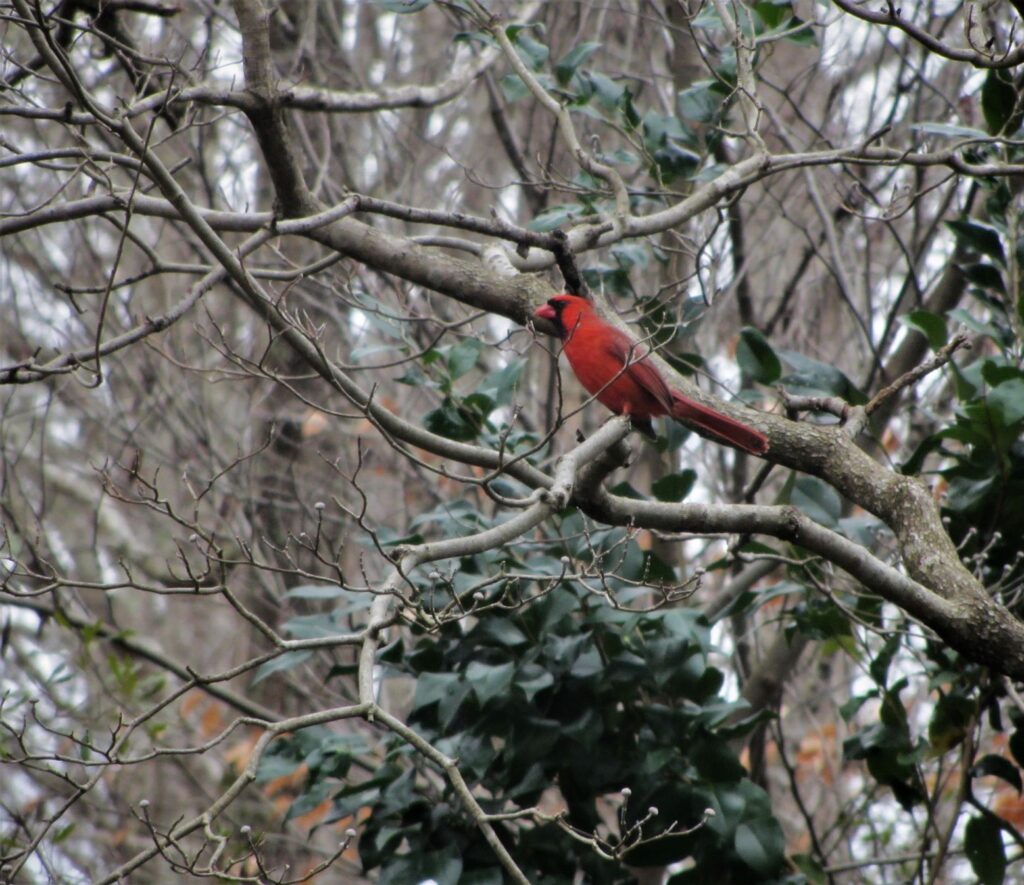
A Northern Cardinal perches on a dogwood tree in winter, after its leaves have fallen and its drupes are gone.
Historic Uses for the Dogwood Tree
Native Americans found many uses for the wood, bark, and roots of this native tree. They made a tea, or decoction, from the well-dried inner bark of the dogwood and also from bark stripped from the tree’s roots. This bitter tea could be used in treating fevers and chills, particularly in areas where malaria and similar fevers could infect them. The decoction could also be used as a disinfectant to treat wounds and stop bleeding. Some also dried the bark and smoked it, mixed with tobacco.
The wood itself is very close grained, heavy and strong, lending itself to many uses for carving, making tools, handles, and other small items that need to be strong, and for starting fires. Dyes and inks can also be made from dogwood’s roots and bark.
Dogwood has been revered as a sacred tree in many Christian communities and associated with Easter, particularly since it blooms around Easter time and bears marks on the ends of its bracts which resemble wounds. Christian legends originating in rural North America describe why the dogwood rarely grows with a straight trunk or branches. Tradition still holds that branches of flowering dogwood should not be cut for use in floral displays indoors, out of respect for this special tree.
Anatomy of a Dogwood Flower
The dogwood’s true flowers are small, almost unnoticeable, and yellow green. They are found in the center of four white or pink ‘bracts.’ A bract is actually a modified leaf which grows at the base of a flower cluster. From a distance, bracts appear to be petals. The beautiful white, reddish or pink ‘petals’ which surround the dogwood’s clusters of tiny flowers are actually bracts which fall away by May. A cluster of green drupes emerges from the clusters of true flowers. The drupes turn scarlet in September as the dogwood’s leaves also turn scarlet in early autumn.
Sowing the Next Generation of Dogwood Trees
Birds distribute dogwood seeds over a wide area, and they grow easily from seed in the garden or the wild. Young trees grow relatively quickly even though tender new leaves and twigs may be grazed by deer. Seedlings and saplings grow well in partial shade, eventually reaching for more sunlight as they mature. I am always happy to notice dogwood seedlings coming up in our garden or even in a container holding another plant. Dogwood seeds may be dropped by birds or buried by squirrels. Sapling dogwood trees grow several feet per year when young and usually bloom by their fourth or fifth spring.
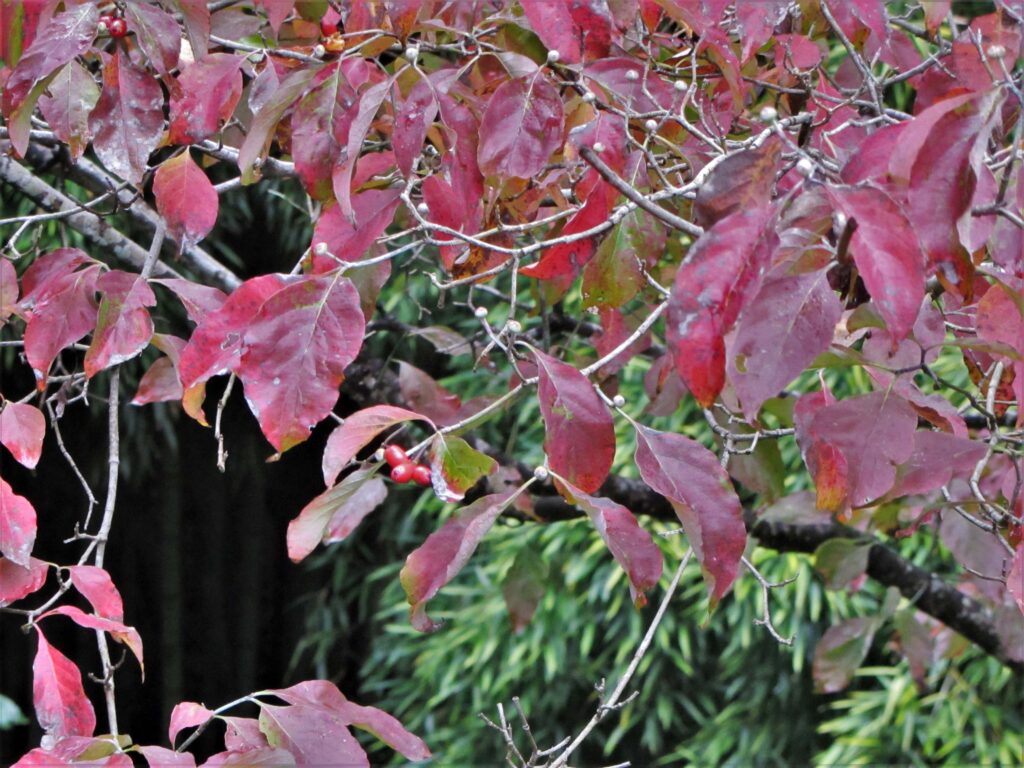
Flowering dogwood’s drupes turn bright scarlet when they ripen in early autumn. Buds for the following spring’s flowers have already formed.
Dogwood Propagation
Dogwood seeds may be gathered and planted outside in a prepared bed or covered container in autumn. They require cold stratification to germinate, and so an outdoor seedbed is a reliable method to grow new trees from gathered seeds. Dogwood trees may also be started from cuttings, particularly from hardwood cuttings of the current year’s growth struck in late autumn. Begin with cuttings when more trees of a particular form or color are needed.
There are many dogwood cultivars of our native C. florida, available with white, pink or red bracts, and some named varieties have increased resistance to spot anthracnose and powdery mildew. Some cultivars have colorful or variegated leaves. Look for named cultivars such as C. florida ‘Appalachian Blush,’ ‘Appalachian Spring,’ ‘Cherokee Brave,’ ‘Cherokee Spring,’ ‘Cherokee Princess,’ and ‘Suwanee Squat,’ which is a dwarf with white flowers.
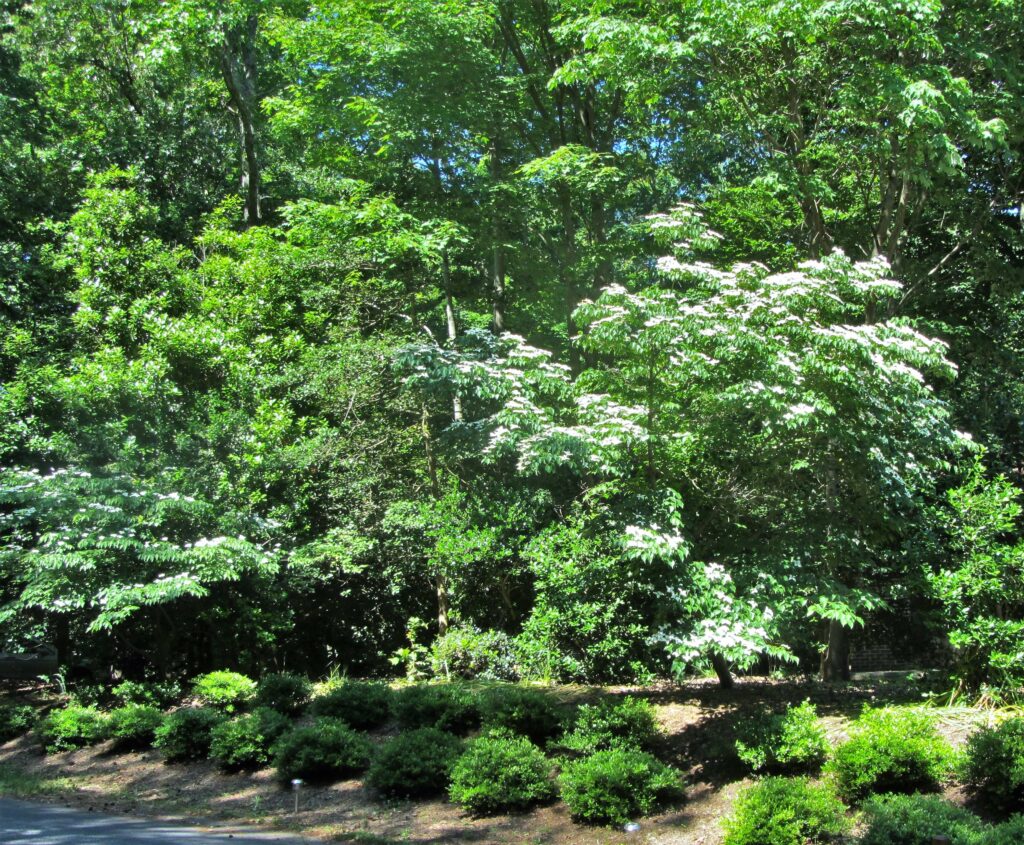
Kousa dogwoods, C. kousa, bloom in May 2021 at the entrance to the Kingspoint neighborhood in James City County.
Additional Popular Cornus Species
There are also several other native and Asian species in the Cornus genus, some with beautifully variegated foliage, colorful stems, disease resistance, or later bloom time. C. kousa, a popular Asian species, is more sun and drought tolerant and isn’t subject to spot anthracnose. It blooms a few weeks later than our native C. florida.
European C. sanguinea is planted for its blood red twiggy growth and may be pruned back frequently to encourage new, colorful stems. It has clusters of small white flowers in spring and purplish black drupes in late summer. Native red-twig dogwood, C. sericea, is also valued for its red, or golden, twiggy growth. It has clusters of small white flowers in spring and white drupes in the autumn. It thrives in wet soil, though it will grow in dry conditions and even on clay and grows as a multi-stemmed shrub to around 9’.
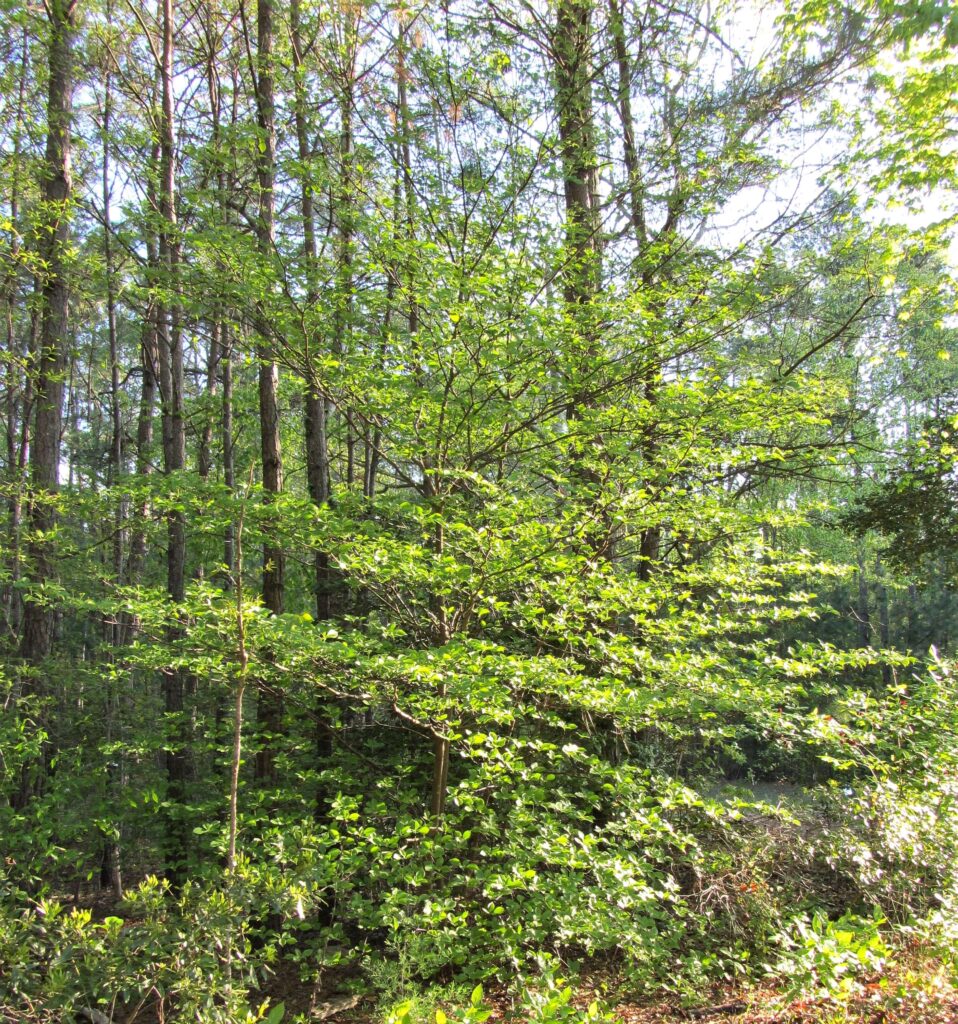
C. alternifolia, the pagoda dogwood, grows at the Williamsburg Botanical Garden and Freedom Park Arboretum in early summer of 2021. Its branches form layers of foliage, reminiscent of the roof of an Asian pagoda.
Many Cornus Species and Hybrids Thrive in Virginia
There are nearly 20 Cornus species which grow well in our area, including other native species. The species name ‘florida’ refers to the large, colorful, showy flowers, actually bracts, on our native flowering dogwood tree. Other native Cornus species have beautiful form and foliage, but less showy flowers, and they make excellent additions to a woodland or shade garden. Consider pagoda dogwood, c. alternifolia, hardy in Zones 3-7 and swamp dogwood, C. amomum, which is more shrub-like and grows well on wetland soils. These graceful trees all flower in mid to late spring and showy drupes follow by late summer. They are ornamental in all seasons, with most species also having exceptional autumn color before their leaves fall.
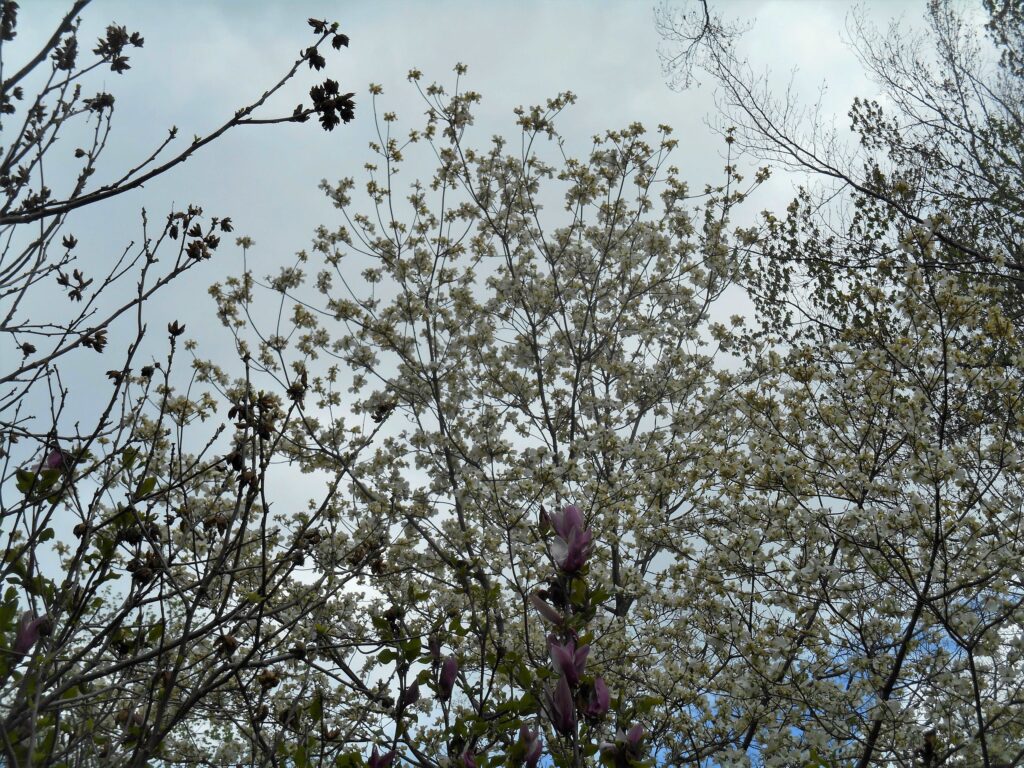
Wild, nature-sown C. florida trees are extremely showy in both spring and autumn. They grow in harmony with other trees as part of the understory growth of a forest or a residential garden. ‘Florida’ in the species name means ‘flowering,’ and doesn’t refer to the state of Florida, which is south of the optimal growing zone for flowering dogwood.
Cornus Hybrids Offer Improved Disease Resistance
Dr. Elwin R. Orton, Jr. of Rutgers University developed a series of hybrid dogwoods by crossing our native C. florida with the Asian C. kousa in an attempt to develop a beautiful landscape tree with greater disease resistance. Cultivars of Cornus x rutgersensis, known as Rutger’s hybrids or Stellar hybrids have been introduced to the market, beginning in the 1990s, to provide mostly sterile, disease resistant trees with particular habits and traits.
Pests, Diseases, and Their Prevention
All Cornus trees are relatively pest free and graceful plants. The anthracnose virus can be a problem for dogwood trees in areas higher than 1800’, and spot anthracnose, powdery mildew, and various types of rot are more common in lower elevations with hot, humid summers. Good hygiene, removing and destroying any affected plant tissue, is important in controlling bacterial and fungal diseases. Various scale insects, the dogwood borer, and leafhoppers may be attracted to dogwood trees.
Aggressive vines, like native grapes, ivy, and even native Smilax may try to colonize dogwood trees. Clip and control the vines at ground level so they don’t shade and weigh down the tree canopy and hold moisture close to the tree’s bark, both weakening the tree and making it more prone to disease. Keep a dogwood tree in good health by maintaining a few inches of mulch under its canopy, and keep the tree watered during drought. Covering and cooling the soil with mulch and maintaining consistent moisture in the soil helps to prevent many problems.
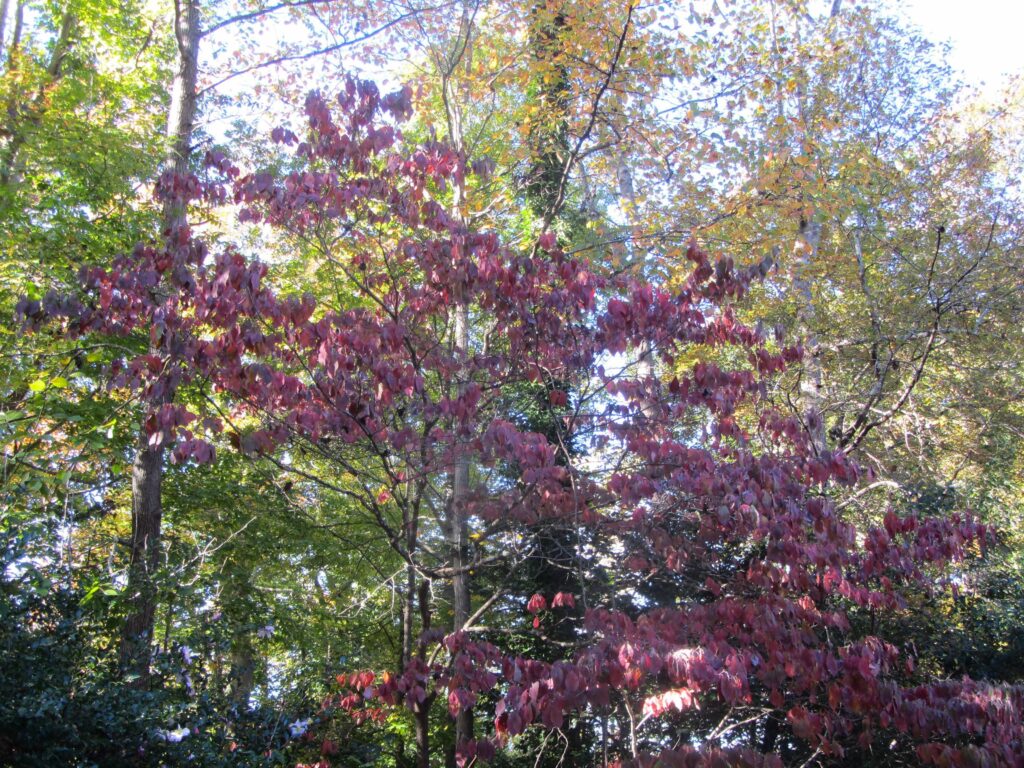
Dogwood trees turn scarlet in late September as Camellia sasanqua begins to bloom.
Incorporating Dogwood Into the Garden
Some gardeners may choose to cultivate shade-loving mosses, hardy ferns, or other ground cover perennials like Hostas or hellebores under their dogwood trees instead of adding fresh mulch each season. Dogwood trees are small enough, and low enough, that they don’t require a lot of space. They occupy an important understory layer in a wildlife-friendly garden.
The last time I counted, we had at least 15 native dogwood trees growing around our yard. This flowering tree is beautiful every day of the year, in every season, but particularly when it blooms in April and turns scarlet by late September. It nearly takes my breath away when we see its canopy filled with white flowers and buzzing with bees against a clear blue sky.
All Photos by E. L. McCoy
Additional Related Posts on This Website
Growing Indigenous Trees from Seeds
A Winter Wildlife Garden- ‘Inviting the Stranger’
Cultivating a Tiny Forest (Part 1)
Cultivating a Tiny Forest (Part 2 ‘PNV’)




